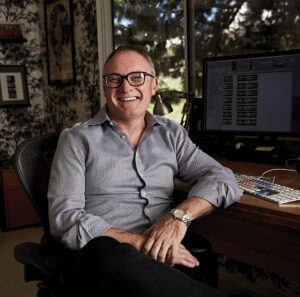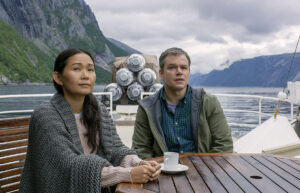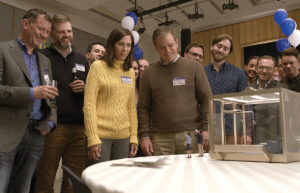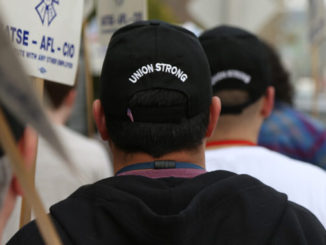
by Steve Hullfish • portraits by Christopher Fragapane
In a CNN.com article about picture editor Kevin Tent, ACE, on the occasion of his Academy Award nomination for cutting director Alexander Payne’s The Descendants (2011), actress Laura Dern — who was in Payne’s first film, Citizen Ruth (1996), also edited by Tent — was quoted as saying of the editor: “Kevin’s art lies in the genius of trusting human beings.”

“That’s so sweet she said that,” replies Tent when reminded recently of the compliment. “She came to the cutting room a lot and we would often analyze takes together with Alexander. Laura has a lot of respect for editors and the process of editing.”
As an editor, Tent likewise attests to an enormous affinity for actors and acting. “I think all editors have a lot of responsibility for the performances of actors,” he continues. “I’m constantly looking and asking, ‘Do I believe that?’ ‘Does that seem completely real?’ And maybe if I take two frames off the take, it seems more believable. Actors will give you so many great options, and you have to look at how the performance in one scene tracks with the performance in the next. Cutting performances is one of my great joys of editing.”
And as Payne’s go-to editor (they have collaborated on eight projects so far), Tent has certainly had his share of shaping some impressive performances in the director’s decidedly offbeat films, the latest of which is Downsizing, due for a December 22 release from Paramount Pictures. Telling the story of Paul and Audrey Safranek (Matt Damon and Kristen Wiig), who believe that many of their problems will be solved by undergoing a new medical/social experiment which will shrink their bodies to the size of action figures, the film — like many of Payne’s previous movies — is an utterly unpredictable blend of comedy, character study and social commentary.
Tent, who won an ACE Eddie Award for The Descendants, and was previously nominated for that award for Nebraska (2013), Sideways (2004), About Schmidt (2002) and Election (1999) — all directed by Payne — discussed his work on Downsizing and more during an interview with CineMontage in October.
CineMontage: You have no credits as an assistant editor. How did you make the jump straight to the editor’s chair?
Kevin Tent: I went to film school at LA City College. My first job was editing educational films. It was really good because I was my own assistant; I had to sync my own dailies and get the films through the lab. My big break was when I got a chance to re-cut a film for Roger Corman; it was kind of a mess. After that, I got my first solo editing credit on another Corman movie called Not of this Earth (1988). It’s pretty hilarious.
CM: How fast did you have to deliver those early Corman movies?

KT: So fast! Not of This Earth was probably a 10-day shoot and then maybe a month and a half or so to finish it. You needed to have an assembly for Roger two or three days after you finished shooting — or faster. If you wanted to be an editor, it was a great place to learn. You could be an assistant one week and cutting a feature the next. Roger had zero patience if something wasn’t working in a film, so I always felt I had to race against his impatience. Keep the film tight and zipping along and not boring.
CM: Those early films must have been cut on film. When did you switch to Avid?
KT: At Corman in those days, it was all Moviolas. Then when I did more expensive B-movies, I would work with an upright cutter and a KEM, when we could afford it.
The first film I did nonlinear was One Good Turn [1996]. We had done Citizen Ruth on film and, after doing One Good Turn, I kept saying to Alexander, “You are going to love this Avid thing! It’s amazing.” So when he got Election, we used an Avid on that. Citizen Ruth was my last movie on film. We couldn’t afford an Avid on that; they were expensive back then.
CM: From your KEM and Moviola days, were there any good habits you carried forward into your nonlinear editing?
KT: The skill of learning where to make a good, or pretty close, edit on the first try. One thing Alexander and I did carry over from cutting on film — and something we still do — is lining up takes. If we had six takes of a line reading, we would cut them all in, watch them in a row and say, “Take three is good and take six is good.” Then we’d take the other ones out. We’d go through all our takes with those line readings back to back and find our favorite, most convincing line readings, then start building the scene. We call them our “hero takes.” It got to be our routine, and we still do it on the Avid.
Of course, with the Avid, we will carry three or four takes, stacking them in our timeline. We’ll have a hero take on the top channel and carry a couple of other favorites as we fine-tune the cut. We’ll go back and review the alternatives and make sure we still have the best one. We keep those in the timeline for a long time — generally until we’re almost done cutting.
CM: We discussed performances earlier; what is it that speaks to you in a performance?
KT: It’s just intuition and really what I feel. So it’s like, “I believe that moment up until here…” and then I’ll try to figure out a nice, elegant way to cut away and come back. But I think it really comes down to feeling something in my gut about a performance — if I believe it.

CM: What about the use of reaction shots and when to know that it’s really more emotional to be off-camera than on?
KT: Very often, reaction shots add a lot of emotion to a scene because if the audience is engaged, they are probably feeling the same way as your actor is. My little theory is that when you use a reaction shot that seems appropriate to a certain moment in the film, it should reinforce what the audience is already feeling. This should add to the impact of the scene or the moment. Reaction shots are so important and that’s why, if you have really good actors, they’re good when it’s not their turn to speak; they’re really engaged in the scene, really reacting and really being real all the way through. You can always steal a reaction from somewhere else too, and sometimes that can be very effective.
I worked on this really good movie several years ago called Disconnect [2012], and in one scene, the director, Henry Alex Ruben, did one of the craziest things that I absolutely loved. After getting all of the takes he needed, he asked the actors to do the scene without any dialogue — do all the action and blocking but don’t speak. It was great for reactions and clean action and sound. We wound up using a lot of it. It was a crazy idea, but really effective.
CM: You’ve worked with many different directors, but you seem to be Alexander Payne’s go-to guy. Tell me about that relationship?
KT: We’re very close after all these years of working together. We spend a lot of time together and have a very respectful relationship. We really talk about specifics — how we can get out of situations, how we can make things better all the time. He’s very respectful of all his crew and actors, so he always gets the best out of people.
CM: What’s your actual methodology of collaborating with him?
KT: We usually work together to build the scenes, but sometimes I say, “I think there’s a better scene here. Let me work on this myself and tomorrow morning I’ll show it to you.”
He’s very good about experimenting with structure, like “Let’s watch the movie without that scene.” One of the reasons I love working with him is that he is always willing to take a fresh look at something. He does that every day while we’re cutting. He’s constantly experimenting with stuff, which is great. There’s always compromise.
We had a lot of screenings on Downsizing; many of them were in the cutting room with just 10 people. We had small screenings at the Paramount lot, and we had a bunch of bigger previews.
CM: How did preview screenings affect the cutting of Downsizing?

KT: Well, the biggest thing that happened out of our previews was that we cut out a big, huge storyteller/narrator element from the head and the tail of the movie. Originally, there was an old man in a cave from 8,000 years in the future telling a bunch of children around a campfire the story of Paul Safranek. It was really funny dialogue, and voiceover from the old storyteller peppered the movie throughout. Then we met him again at the end. It made the movie even funnier and weirder than it is now. It was a tough loss.
But as good as it was, it seemed our audience lost patience and we realized we had to get to Paul’s introduction as soon as we could. The scene and the narration added another three or four minutes to the top of the movie, which made it longer to get to Matt Damon’s character. You can let some suspense build, but in Downsizing, and most movies, audiences want to know who they’re supposed to be following, what the movie’s about and how they’re supposed to be feeling about it. Then they can settle back, relax and get taken on the journey. But if you don’t get them right in the beginning and hold their hand for a little, you have the potential for not ever getting them engaged in the movie. That’s my theory at least.
CM: There are a lot of different tones in the film: the excitement, fun and comedy of the Leisure Land intro, and then the more somber and thoughtful series of goodbyes and “smallness” issues. What were the discussions balancing how long to be in each of those tonal sections?
KT: That’s the tricky thing with all of Alexander’s movies, and this one was no different. It’s hard to remember all the many adjustments, deletions and additions we did in those sections, but we did a lot. Pace was always an issue.
One scene of interest that we dropped was Audrey freaking out the night before they left to be downsized. It came after the goodbye scene with her dad, the drunk guy in the bar, and she and Paul hugging their friends in the parking lot. The scene was of Paul and Audrey sleeping on a mattress on the floor of their empty house. She was crying and then explodes in anger, yelling at Paul and blaming him for his failures that forced them into the position of having to downsize. We loved it and hung onto it for a long time. It was really powerful, heartbreaking and real…but we really needed to get to the downsizing sequence quicker, so we dropped it.
CM: There’s also a section where they’re legally agreeing to the downsizing procedure. Almost the entire scene plays on reactions instead of on the person speaking.
KT: We really wanted to hold off on revealing the closer shot of the intake woman till her line, “…injury or death.” So we played a huge portion of the questions on Paul and Audrey. One of my favorite moments is watching Kristen Wiig while the intake woman is reading all the warnings. The range of emotions crossing her face is priceless. We did drop a number of lines in that scene, even though we were in a locked-off two shot. We did split the screen between Paul and Audrey and, using Avid’s FluidMorphs, we dropped lines and then morphed them back in sync with each other.
CM: There is a long close-up on the Vietnamese woman, Ngoc Lan Tran (Hong Chau), as she talks about going to Norway. Was there traditional coverage for that?
KT: This is one of those moments — at least for me — where I can’t believe how lucky I am to be an editor. The dailies came in and I watched take one and was blown away by what she did! It was beautiful, weird, heartbreaking and funny all rolled into one. Take 1! I couldn’t believe the power of her performance. It’s amazing. Alexander shot two takes; I think he had always planned on having a dolly into a close-up.
CM: The pacing of her delivery was slightly off socially, but seemed perfect for her character.
KT: I think the brilliant thing about Ngoc’s character is that she’s actually so innocent. And the words she says don’t really matter to her; they have no negative connotation in her mind. So she says these shocking sentences, but with such innocence and sweetness — and that’s where the humor comes out. We really let her performance guide our cutting, trying to capture her transitions. So in some cases, that meant we let moments breathe.
For example, in the moment when she asks Paul if the sex was a “love f*ck,” there is a beautiful, sincere, natural transition from her being excited to confused to hurt. She does an amazing job. We just let her do her thing. That performance of hers is movie magic in my book.






